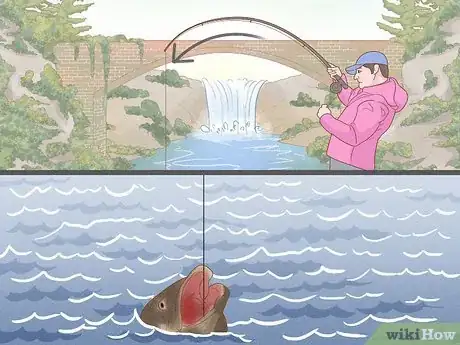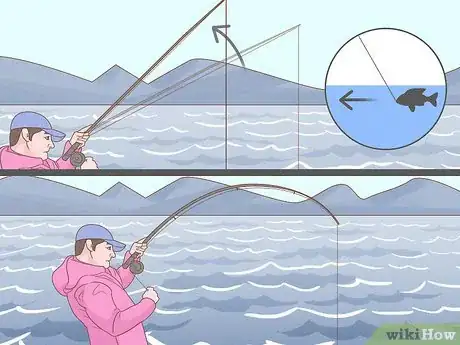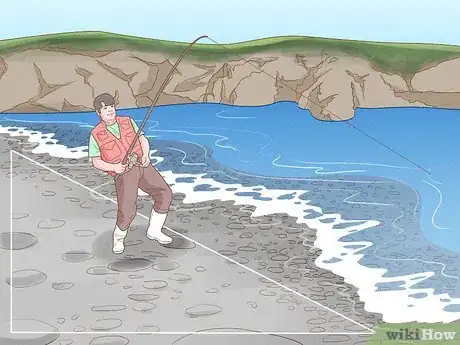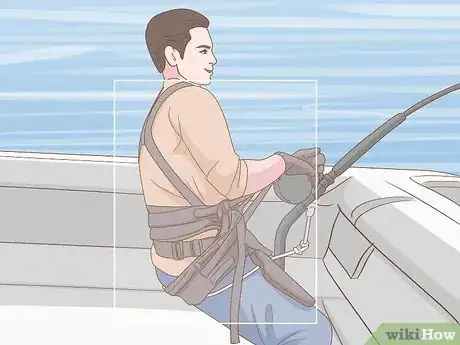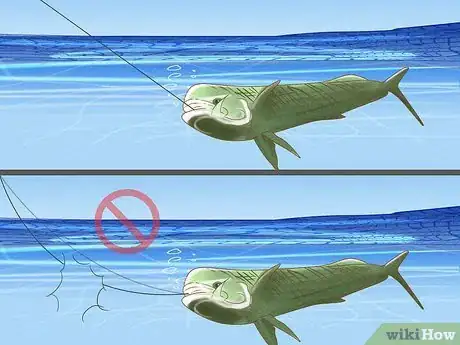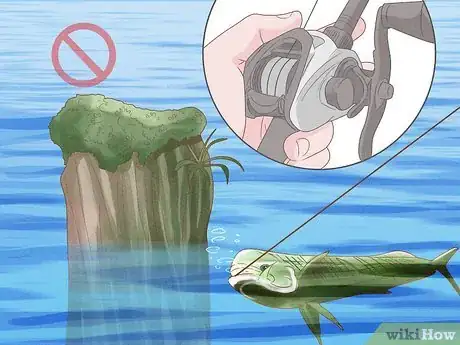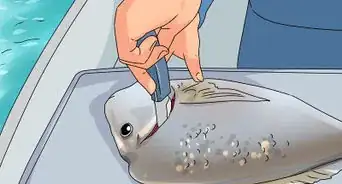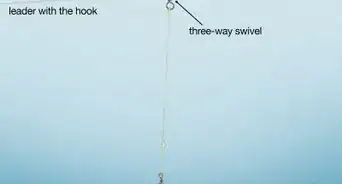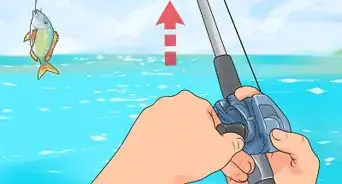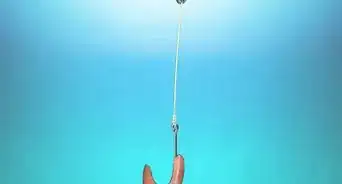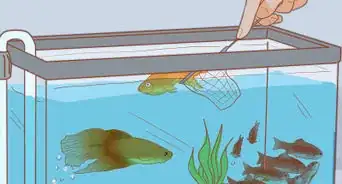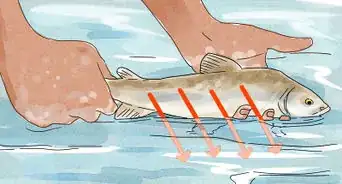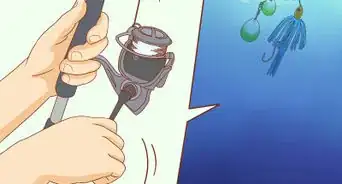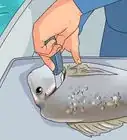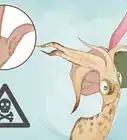X
wikiHow is a “wiki,” similar to Wikipedia, which means that many of our articles are co-written by multiple authors. To create this article, 19 people, some anonymous, worked to edit and improve it over time.
This article has been viewed 93,461 times.
Learn more...
Reeling in a large fish can be very hard. Large fish include carp,catfish,and bass in fresh water and is salt water they are wahoo, dolphin, tuna, and marlin. However, fighting a five pound fish with ultralight tackle is also fun. It is all relative.
Steps
-
1Let the rod do the work once you know you have solidly hooked the fish. Let the guides, water resistance of the line, line elasticity and drag work together to tire the fish.[1]
- Fight the fish with smooth, nonstop pressure, assuming that your reel drag was set correctly.
- Then start to reel the fish in. Be careful because, depending on the size of the fish, it could snap your line. That's how you reel in a large fish.
- The drag if your reel should be set as a percentage of the breaking strength of your main line. For example, if your main line is 50lb test, your drag could be set with a 12lb weight.
-
2Work the fish closer and closer to you by pulling the rod tip up, then reeling rapidly as you drop the tip down.[2]
- Do not pump the rod too far back, which can cause your rod to break.
- Avoid creating slack in the line at any time – this can enable the fish to spit out the hook or break your line.
Advertisement -
3Use the space around you if you are fishing from shore. When fighting big fish from shore, an alternate technique if the ground is flat, is to walk backwards and to quick reel in the slack when walking forward.[3]
- Additionally, you can use this walking method when the fish is big and your rod will break if you pump it back with just your arms.
- Generally, when fishing from shore you want to reel the fish in as quickly as possible because there are many objects that can break your line such as rocks, reefs, pilings, drop-offs, caves etc.
-
4Wear out big fish before landing them on the boat. Big game fish can be dangerous; it's better to tire the fish out and avoid bringing it to the boat "green".
- Do not "horse" a big fish in; it will be dangerous to gaff. A marlin is a bit flexible and a green marlin thrashing about when gaffing it is dangerous because of the marlin's bill and the double hook set up that marlin lures have.
-
5Use the boat to your advantage. With many big fish, it is best to keep the boat moving forward to keep the fish from heading down. Keep big fish close to the surface.
- Marlin will practically die down at the depths and bringing a marlin up from the depths is a terrible experience. Sharks are also a problem when it takes too long to bring in a marlin. A half dead marlin is dead weight, with 300 yards (274.3 m) of line out of the reel, the line elasticity even with a braided line, is enormous. Hauling in a half dead marlin from the depths is like carrying an unconscious person up a ladder; avoid letting marlins go deep at all costs.
- Tuna when caught trolling, should also be fought with the boat going forward to avoid having the tuna head for the bottom. A tuna is much stronger than a marlin and fighting a tuna down in the depths, will be exceedingly difficult. Big sharks may also eat the tuna if the fight is too long.
-
6Use a harness. Fighting big fish from a boat with a harness lets you use the strong muscles of your back, instead of your arms, to pump the rod back. Even without a harness, use your back and body sway to pump the rod backwards, do not use your arm strength to manhandle the heavy trolling tackle.[4]
-
7Let the fish run when it is to your advantage. Inshore, when you have a big fish on, if the inside has many obstacles to cut the line, let the fish run outside in deep water, before bringing it in for landing.
- With the fish exhausted, when you bring it to the landing, crank the reel continuously whether the rod is in the upstroke or down stroke.
- The additional advantage of continuous maximum pressure, just before a hairy landing, is to not allow the fish to breathe with its gill flaps.
-
8For any type of fish or tackle, the line must be always tight so the fish will not throw the hook. Additionally, your motions should be smooth so the hole in the fish's mouth, from the hook, will not get bigger, thus making the hook easier to dislodge.[5]
-
9Stop a running fish when necessary. In certain do or die situations, it is correct to take a stand and stop a running fish.
- When the spool is almost empty, apply pressure on the spinning reel spool with your fingertips. On a big game reel, with your gloved hand, you can thumb the spool sides for extra resistance.
- A spool that is almost empty of line has a lot of resistance compared to when the spool is full of line. In this case, you could either chase the fish by turning the boat around and following it, or skipper could put the motor in reverse and go slowly in that direction. With the latter, the fish could go down to the depths and some water could splash into the boat and have to be bailed out.
- When the fish is headed for an object, that will almost certainly cut the line, when inshore fishing, is another do or die case. For example, your fish is headed for the reef and your taut line will cut in an instant when it touches the reef, then you should raise the rod high and either tighten the drag or apply pressure to the line in your spinning reel with your forefinger.
- In fresh water, the tree stump is the absolute line breaker and you must do everything to stop the fish from going there. Make the fish stop or break the line trying. Lift the rod as much vertically without breaking it at its lower back, put manual pressure on the spool and take few steps backward. Note: the rod as it bends more and more, eventually will bend to above the reel - this is the lower back of the rod.
- In brackish water, mangrove roots are as troublesome as tree stumps, so when a fish is headed for mangrove roots, put yourself in the make or break mode. In many cases, there will not be enough time to tighten the drag, adjust the resistance by applying pressure to the spool with your hand.
Advertisement
Warnings
- Carp have spikes on their backs. Try not to touch them.⧼thumbs_response⧽
Advertisement
References
- ↑ https://news.orvis.com/fly-fishing/pro-tips-how-to-fight-big-fish
- ↑ https://midcurrent.com/techniques/fighting-big-fish-a-primer/
- ↑ https://midcurrent.com/techniques/fighting-big-fish-a-primer/
- ↑ https://www.sportfishingmag.com/break-stalemate/
- ↑ https://news.orvis.com/fly-fishing/pro-tips-how-to-fight-big-fish
About This Article
Advertisement
